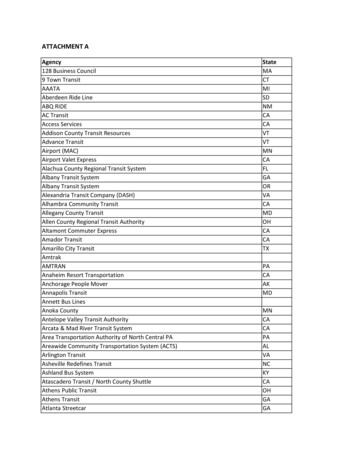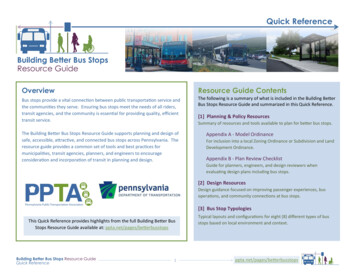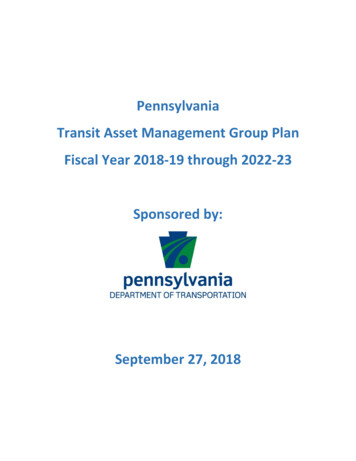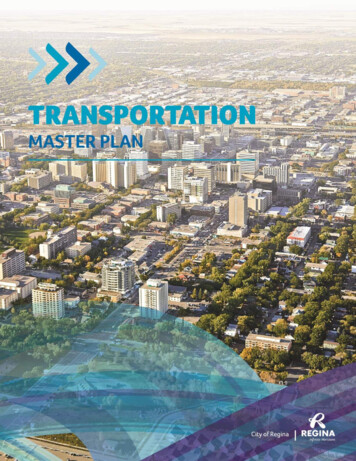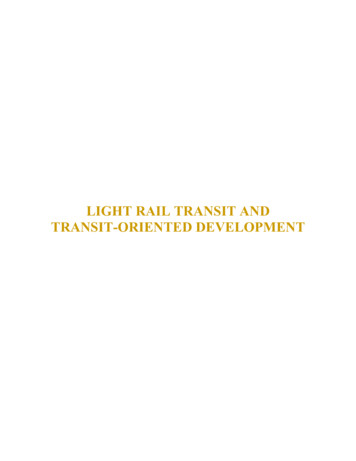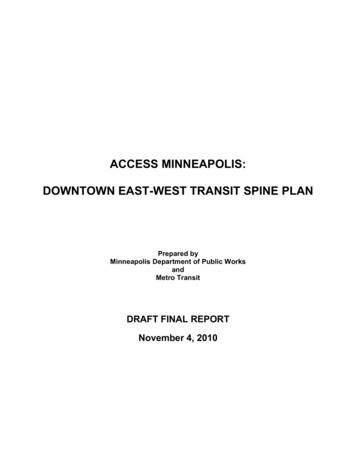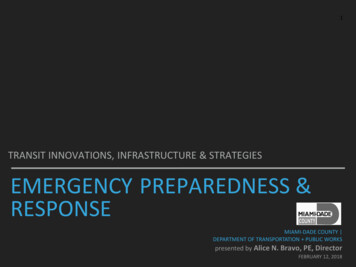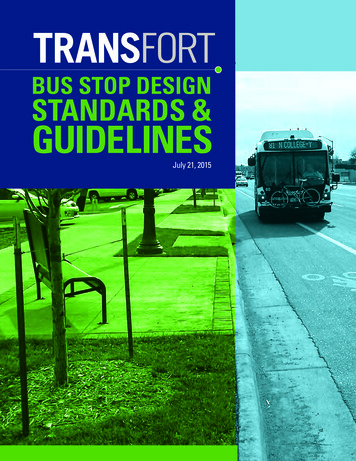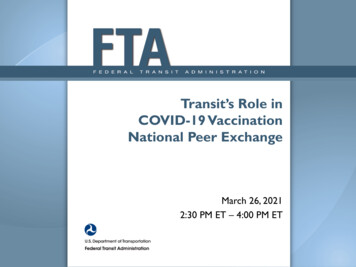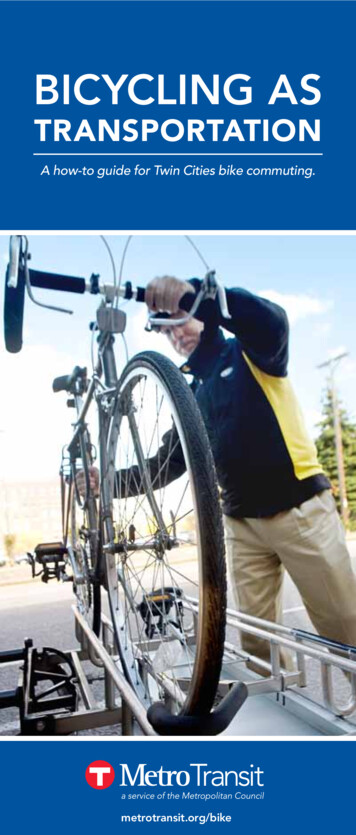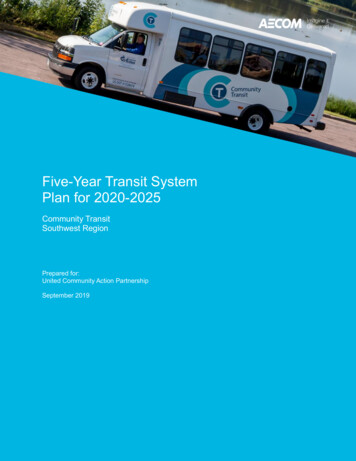
Transcription
Five-Year Transit SystemPlan for 2020-2025Community TransitSouthwest RegionPrepared for:United Community Action PartnershipSeptember 2019
Five-Year Transit System Plan for 2020-2025AECOMCommunity Transitii
Five-Year Transit System Plan for 2020-2025Community TransitTable of Contents1.2.3.4.5.6.7.8.9.10.Executive Summary . 1Why a Five-Year System Plan? . 3Agency Overview . 43.1 Transit Agency Background . 63.2 Governance . 63.3 Mission and Goals . 63.4 Decision-Making Process. 73.5 Service Area Overview . 73.6 Regional Connections . 26Agency Transit Services. 284.1 Ridership . 314.2 Service Delivery . 324.3 Users . 334.4 Trip Patterns . 34Capital . 365.1 Background . 365.2 History . 412020-2025 Annual Needs. 446.1 Needs Identification Process. 446.2 List of 2020–2025 Needs . 446.3 Historical and Projected Annual Summary . 446.3.1 Fleet . 446.3.2 Facilities . 476.3.3 Technology . 486.3.4 Other . 48System Performance . 487.1 Historical Performance. 507.2 Projected Performance . 51Operations . 548.1 Background . 548.2 Historical and Projected Annual Summary . 568.3 Staffing . 588.4 2020-2025 Annual Needs . 598.4.1 Staffing Needs. 618.4.2 Operations Funding Needs . 61Financial . 629.1 Background . 659.2 History . 669.3 Budgeted Revenue . 699.4 2020-2025 Needs vs. Projected Revenue . 70Agency Strategic Direction . 7110.1 Requirements . 7110.1.1 Federal Transit Administration (FTA) . 7110.1.2 Olmstead Plan . 7210.1.3 Title VI . 72AECOMiii
Five-Year Transit System Plan for 2020-2025Community Transit10.1.4 Americans with Disabilities Act (ADA) . 7310.1.5 Agency . 7410.2 Opportunities . 7410.2.1 Southwest Region . 7410.2.2 Community Transit . 7710.3 Risks/Challenges . 7710.3.1 Southwest Region . 7710.3.2 Community Transit . 7911. Increasing Transit Use for Agency . 7911.1 Marketing . 7911.2 Action Plan . 80Appendix A Capital and Operating Plans for 2020-2025 . 83Appendix B Community Survey Results . 89Appendix C Transit Need and Demand Analysis (TCRP 161) . 95AECOMiv
Five-Year Transit System Plan for 2020-2025Community TransitFiguresFigure 1. System-Wide Ridership (2013-2017). 1Figure 2. High Priority Unconstrained Needs for Community Transit . 2Figure 3. 2020-2025 Plan, Local Revenue Requirements . 2Figure 4. Location Map . 5Figure 5. UCAP Transportation Program Organizational Chart . 8Figure 6. Population Density . 18Figure 7. Persons Living Below the Poverty Level . 20Figure 8. Zero-Vehicle Households . 21Figure 9. Economic Health Index . 22Figure 10. Transit Vulnerability Index . 23Figure 11. Job Density . 24Figure 12. Primary Work Destinations for Employees Residing in the Community TransitService Area . 25Figure 13. Major Trip Generators . 27Figure 14. Community Transit Services . 29Figure 15. Ridership by Month (2015-2017) . 31Figure 16. 2017 Community Transit Selected Demographic Characteristics . 33Figure 17. Summary of Trip Purposes (January through June 2018). 34Figure 18. Service Area Demand Response Trip Patterns . 35Figure 19. Actual and Projected Maintenance Costs (2016-2019) . 41Figure 20. Fleet Vehicles (2013-2017) . 43Figure 21. Trip Denials (January through March 2019). 51Figure 22. 2018 Budgeted Operational Expenses . 55Figure 23. Actual and Projected Operating Costs by Year (2013-2025) . 58Figure 24. Community Transit Volunteer Drivers (2014-2018) . 59Figure 25: 2018 Operating Revenue by Source . 63Figure 26. Community Transit Operating Expenditure Funding Sources (2013-2017)a . 67Figure 27. Community Transit Capital Expenditure Funding Sources (2013-2017)a . 68Figure 28. Change in Total Available Capital and Operating Revenue by Source (20132017)a . 69Figure 29. Grant Requests and Awards (2018-2019) . 70Figure 30. 2020-2025 Plan, Local Revenue Requirements . 71Figure 31. Southwest Region . 76Figure 32. How Individuals Heard About Community Transit . 89Figure 33. Where Respondents are From Based on Usage . 90Figure 34. Smartphone App Usage to Schedule Rides. 90Figure 35. Potential Use of Smartphone app for Scheduling . 91AECOMv
Five-Year Transit System Plan for 2020-2025Community TransitTablesTable 1. Demographic and Socioeconomic Profile . 9Table 2. Demographic and Socioeconomic Profile by Community: Cottonwood County . 10Table 3. Demographic and Socioeconomic Profile by Community: Jackson County . 11Table 4. Demographic and Socioeconomic Profile by Community: Lincoln County . 12Table 5. Demographic and Socioeconomic Profile by Community: Lyon County . 13Table 6. Demographic and Socioeconomic Profile by Community: Murray County . 14Table 7. Demographic and Socioeconomic Profile by Community: Pipestone County . 15Table 8. Demographic and Socioeconomic Profile by Community: Redwood County . 16Table 9. Demographic and Socioeconomic Profile by Community: Rock County . 17Table 10. Community Transit Service Area Travel Patterns by County . 26Table 11. Level of Service . 30Table 12. 2017 Operating Statistics . 30Table 13. 2013-2017 Ridership by Route/Service. 31Table 14. 2017 Ridership Performance . 32Table 15. Passenger Demographics. 33Table 16. Top Demand Response Origin-Destination Pairs (2018) . 36Table 17. Vehicle Fleet . 37Table 18. Facilities . 39Table 19. Maintenance Costs (2016-2019) . 41Table 20. Capital Plan (2019-2025) . 43Table 21. Unconstrained Needs List . 45Table 23. Community Transit Historical Performance (2013-2018)*. 50Table 22. 2018 Cost Efficiency and Service Effectiveness by Service . 49Table 24. Community Transit Performance Metrics . 53Table 25: 2018 Operating Budget Request. 55Table 26. System Cost Efficiency by Year (2013-2020)a . 57Table 27: 2018 Community Transit Staffing . 58Table 28. Transit Need by County . 60Table 29. Transit Demand by Service Area. 60Table 30. 2018 Operating Financial Profile . 63Table 31. Fare Structure Effective January 2019 . 64Table 32. Operating Transit Programs Required Local Match . 66Table 33. Community Transit Operating Expenditures (2013-2017)a . 66Table 34. Community Transit Capital Expenditures (2013-2017)a . 68AECOMvi
Five-Year Transit System Plan for 2020-2025Community TransitAcronymsACSAmerican Community SurveyADAAmericans with Disabilities ActFTAFederal Transit AdministrationGMTIPGreater Minnesota Transit Investment PlanGTFSGeneral Transit Feed SpecificationLEHDLongitudinal Employer-Households DatasetLEPLimited English ProficiencyM,T,W,R,FMonday, Tuesday, Wednesday, Thursday, FridayMnDOTMinnesota Department of TransportationMPOMetropolitan Planning OrganizationMPTAMinnesota Public Transit AssociationMVLSTMotor Vehicle Lease Sales TaxMVSTMotor Vehicle Sales TaxNTDNational Transit DatabaseRDORegional Development OrganizationTACTransportation Advisory CommitteeTCRPTransit Cooperative Research ProgramU.S.C.United States CodeUCAPUnited Community Action PartnershipUSDOTUnited States Department of TransportationAECOMvii
Five-Year Transit System Plan for 2020-2025AECOMCommunity Transitviii
Five-Year Transit System Plan for 2020-2025Community TransitGlossaryAccess: The opportunity to reach a given destination within a certain timeframe or withoutsignificant physical, social, or economic barriers.Accessible Vehicle: A public transportation vehicle that does not restrict access, is usable, andprovides allocated space and/or priority seating for individuals who use mobility devices.Americans with Disabilities Act (ADA): The Americans with Disabilities Act, passed in July1991, gave direction to local transit agencies to ensure full access to transportation for personswith disabilities.Capital Cost: The cost of equipment and facilities required to support transportation systems,including vehicles, radios, shelters, software, etc.Central Transfer Point: A central meeting place where routes or zonal demand-responsivebuses intersect so that passengers may transfer. Routes are often timed to facilitate transferringand depart once passengers have had time to transfer. When all routes arrive and depart at thesame time, the system is called a pulse system. The central transfer point simplifies transferswhen there are many routes (particularly radial routes), several different modes, and/orparatransit zones. A downtown retail area is often an appropriate site for a central transfer point,as it is likely to be a popular destination, a place of traffic congestion and limited parking, and aplace where riders are likely to feel safe waiting for the next bus. Strategic placement of thetransfer point can attract riders to the system and may provide an opportunity for joint marketingpromotions with local merchants.Circulator: A bus that makes frequent trips around a small geographic area with numerousstops around the route. It is typically operated in a downtown area or area attracting tourists,where parking is limited, roads are congested, and trip generators are spread around the area.It may be operated all-day or only at times of peak demand, such as rush hour or lunchtime.Commuter Bus Service: Transportation designed for daily, round-trip service, whichaccommodates a typical 8-hour, daytime work shift (e.g., an outbound trip arriving at anemployment center by 8 a.m., with the return trip departing after 5 p.m.).Coordination: Coordination means pooling the transportation resources and activities ofseveral agencies. The owners of transportation assets talk to each other to find ways tomutually benefit their agencies and their customers. Coordination models can range in scopefrom sharing information, to sharing equipment and facilities, to integrated scheduling anddispatching of services, to the provision of services by only one transportation provider (withother former providers now purchasing services). Coordination may involve human serviceagencies working with each other or with public transit operations.Dedicated Funding Source: A funding source that, by law, is available for use only to support aspecific purpose and cannot be diverted to other uses (e.g., the federal gasoline tax can only beused for highway investments and, since 1983, for transit capital projects).Demand-Responsive Service: Service to individuals that is activated based on passengerrequests. Usually passengers call the scheduler or dispatcher and request rides for dates andtimes. A trip is scheduled for that passenger, which may be canceled by the passenger. Usuallyinvolves curb-to-curb or door-to-door service. Trips may be scheduled on an advancedreservation basis or in “real-time.” Usually smaller vehicles are used to provide demandresponsive service. This type of service usually provides the highest level of service to thepassenger but is the most expensive for the transit system to operate in terms of cost per trip. Inrural areas with relatively high populations of elderly persons and persons with disabilities,demand-responsive service is sometimes the most appropriate type of service. Sub-optionsAECOMix
Five-Year Transit System Plan for 2020-2025Community Transitwithin this service type are discussed in order of least structured to most structured, in terms ofrouting and scheduling. Pure Demand-Responsive Service: Drivers pick up and drop off passengers at any pointin the service area, based on instructions from the dispatcher. In pure demand-responsivesystems, the dispatcher combines immediate requests, reservations, and subscriptionservice for the most efficient use of each driver’s time. Zonal Demand-Responsive Service: The service area is divided into zones. Buses pick upand drop off passengers only within the assigned zone. When the drop off is in anotherzone, the dispatcher chooses a meeting point at the zone boundary for passenger transferor a central transfer is used. This system ensures that a vehicle will always be within eachzone when rides are requested. Flexibly Routed and Scheduled Services: Flexibly routed and scheduled services havesome characteristics of both fixed route and demand-responsive services. In areas wheredemand for travel follows certain patterns routinely, but the demand for these patterns is nothigh enough to warrant a fixed route, service options such as checkpoint service, pointdeviation, route deviation, service routes, or subscription service might be the answer.These are all examples of flexible routing and schedules, and each may help the transitsystem make its demand-responsive services more efficient while still maintaining much ofthe flexibility of demand responsiveness.Dial-A-Ride Service: A name that is commonly used for demand-responsive service. It ishelpful in marketing the service to the community, as the meaning of “dial-a-ride” may be moreself-explanatory than “demand-responsive” to someone unfamiliar with transportation terms.Express Bus Service: Express bus service characteristics include direct service from a limitednumber of origins to a limited number of destinations with no intermediate stops. Typically,express bus service is fixed route/fixed schedule and is used for longer distance commuter trips.The term may also refer to a bus that makes a limited number of stops while a local bus makesmany stops along the same route but as a result takes much longer.Farebox Recovery Ratio: The percentage of operating costs covered by revenue from faresand contract revenue (total fare revenue and total contract revenue divided by the totaloperating cost).Fares: Revenue from cash, tickets, and pass receipts given by passengers as payment forpublic transit rides.Federal Transit Administration (FTA): An operating administration within the United StatesDepartment of Transportation that administers federal programs and provides financialassistance to public transit.Feeder Service: Local transportation service that provides passengers with connections to alonger-distance transportation service. Like connector service, feeder service is service in whicha transfer to or from another transit system, such as an intercity bus route, is the focal point orprimary destination.Fixed Route: Transportation service operated over a set route or network of routes on a regulartime schedule.Goal: A community’s statement of values for what it wants to achieve.Headway: The length of time between vehicles moving in the same direction on a route.Headways are called short if the time between vehicles is short and long if the time betweenthem is long. When headways are short, the service is said to be operating at a high frequency;if headways are long, service is operating at a low frequency.AECOMx
Five-Year Transit System Plan for 2020-2025Community TransitIntercity Bus Service: Regularly scheduled bus service for the public that operates with limitedstops over fixed routes connecting two or more urban areas not near, that has the capacity fortransporting baggage carried by passengers, and that makes meaningful connections withscheduled intercity bus service to more distant points, if such service is available. Intercity busservice may include local and regional feeder services, if those services are designed expresslyto connect to the broader intercity bus network.MAP-21: Moving Ahead for Progress in the 21st Century Act, signed into law in July 2012. MAP21 established surface transportation funding programs for federal fiscal years 2013 and 2014.Measure: A basis for comparison, or a reference point against which other factors can beevaluated.Motor Vehicle Sales Tax: A source of revenue for Minnesota public transit. The percentages ofthis revenue source designated for metropolitan area and Greater Minnesota transit are definedin Minn. Stat. 297B.09.Operating Expenditures: The recurring costs of providing transit service (e.g., wages, salaries,fuel, oil, taxes, maintenance, insurance, marketing, etc.).Operating Revenue: The total revenue earned by a transit agency through its transitoperations. It includes passenger fares, advertising, and other revenues.Paratransit Service: "Paratransit" means the transportation of passengers by motor vehicle orother means of conveyance by persons operating on a regular and continuing basis and thetransportation or delivery of packages in conjunction with an operation having the transportationof passengers as its primary and predominant purpose and activity but excluding regular routetransit. "Paratransit" includes transportation by car pool and commuter van, point deviation androute deviation services, shared-ride taxi service, dial-a-ride service, and other similar services.Passenger Trip (Unlinked): Typically, one passenger trip is recorded any time a passengerboards a transportation vehicle or other conveyance used to provide transportation. “Unlinked”means that one trip is recorded each time a passenger boards a vehicle, no matter how manyvehicles that passenger uses to travel from their origin to their destination.Performance Indicator: An indicator is a metric that provides meaningful information about thecondition or performance of the transportation system but is neither managed to nor used toevaluate the effectiveness of policies, strategies, or investments.Performance Measure: A performance measure is a metric that measures progress toward agoal, outcome, or objective. This definition covers metrics used to make decisions or evaluatethe effectiveness or adequacy of a policy, strategy, or investment.Performance Target: A target is a specific performance level representing the achievement of agoal, outcome, or objective.Point Deviation Service: A type of flexible route transit service in which fixed scheduled stops(points) are established but the vehicle may follow any route needed to pick up individuals alongthe way if the vehicle can make it to the fixed points on schedule. This type of service usuallyprovides access to a broader geographic area than does fixed route service but is not as flexiblein scheduling options as demand-responsive service. It is appropriate when riders change fromday to day but the same few destinations are consistently in demand. Also sometimes calledcheckpoint service.Public Transportation: Transportation service that is available to any person upon payment ofthe fare either directly, subsidized by public policy, or through some contractual arrangement,and that cannot be reserved for the private or exclusive use of one individual or group. “Public”AECOMxi
Five-Year Transit System Plan for 2020-2025Community Transitin this sense refers to the access to the service, not to the ownership of the system thatprovides the service.Revenue Hours: The number of transit vehicle hours when passengers are being transported.Calculated by taking the total time when a vehicle is available to the public with the expectationof carrying passengers. Excludes deadhead hours, when buses are positioning but not carryingpassengers, but includes recovery/layover time.Ridership: The total of all unlinked passenger trips including transfers.Ridesharing: A form of transportation, other than public transit, in which more than one personshares the use of a vehicle, such as a van or car, to make a trip. Variations include carpooling orvanpooling.Route Deviation Service: Transit buses travel along a predetermined alignment or path withscheduled time points at each terminal point and in some instances at key intermediatelocations. Route deviation service is different than conventional fixed route bus service in thatthe vehicle may leave the route upon requests of passengers to be picked up or returned todestinations near the route. Following an off-route deviation, the vehicle typically returns to thepoint at which it left the route. Passengers may call in advance for route deviation or mayaccess the system at predetermined route stops. The limited geographic area within which thevehicle may travel off the route is known as the route deviation corridor.Section 5304 (State Transportation and Planning Program): The section of the FederalTransit Act of 1991, as amended, that provides financial assistance to the states for purposes ofplanning, technical studies and assistance, demo
requests. Usually passengers call the scheduler or dispatcher and request rides for dates and times. A trip is scheduled for that passenger, which may be canceled by the passenger. Usually involves curb-to-curb or door-to-door service. Trips may be scheduled on an advanced reservation basis or in "real-time."
